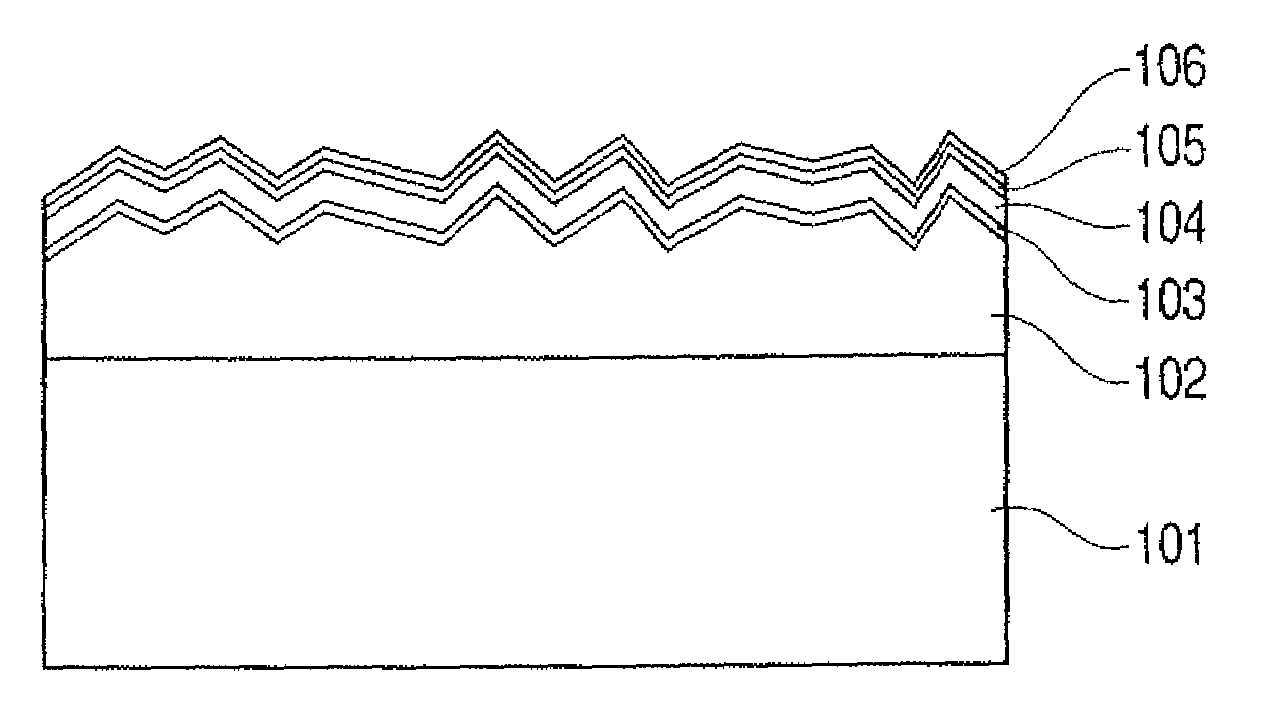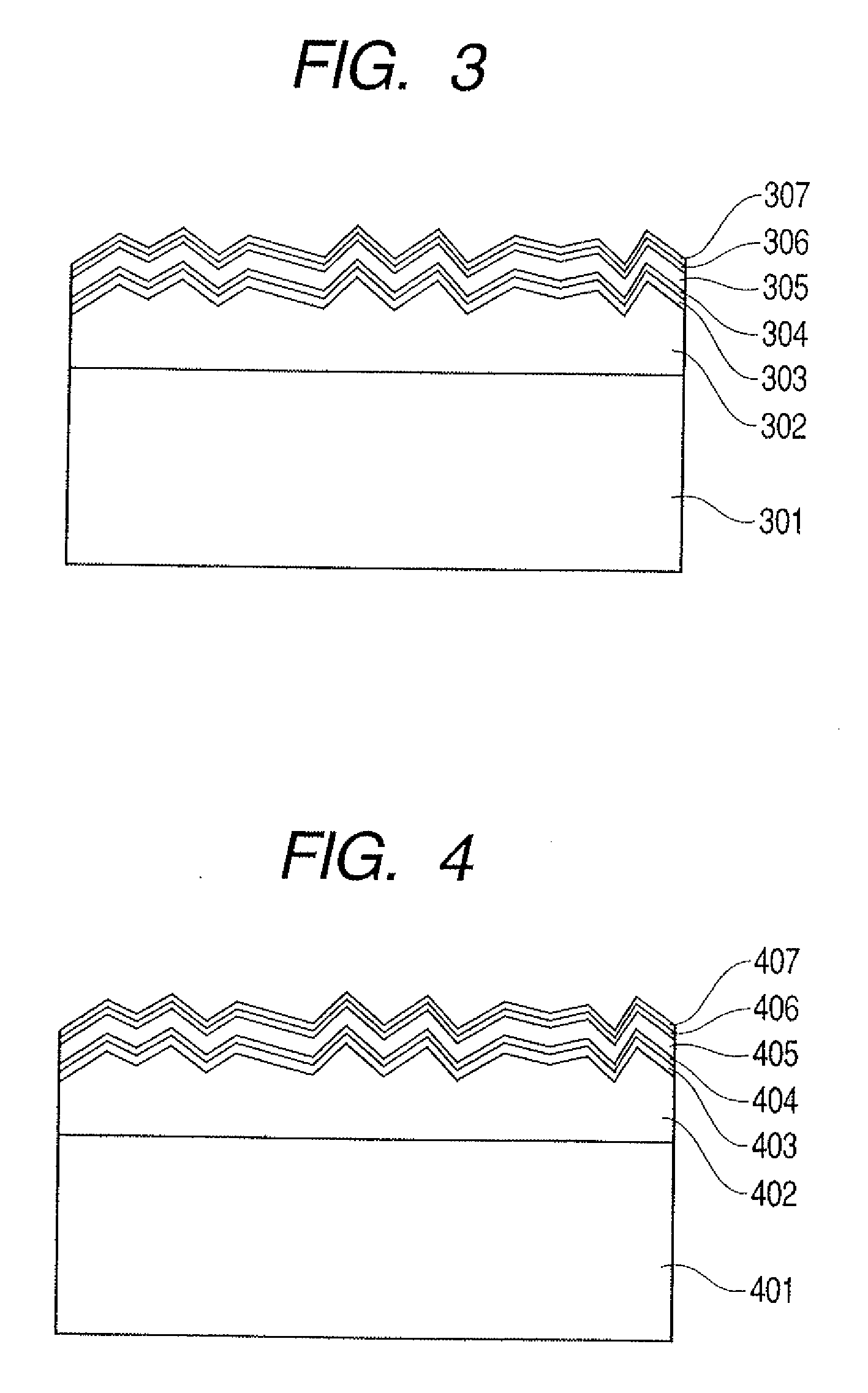Photovoltaic device and manufacturing method thereof
a photovoltaic device and manufacturing method technology, applied in the field of improved photovoltaic devices, can solve the problems of limited photovoltaic semiconductor layers, low conversion efficiency of solar cells for converting optical energy into electrical energy, and increase in material costs, so as to prevent a reduction in photoelectric conversion efficiency, increase in cost, and uneven
- Summary
- Abstract
- Description
- Claims
- Application Information
AI Technical Summary
Benefits of technology
Problems solved by technology
Method used
Image
Examples
embodiment 1
[0056]FIGS. 1 and 2 show the first example of the preferred embodiments of the present invention.
[0057]FIG. 1 shows a structure in which a polycrystalline silicon layer is formed on a silicon base by liquid phase growth to obtain a substrate and a single cell made of thin film system silicon is formed above the substrate.
[0058]In FIG. 1, a photovoltaic device includes a base 101 made of silicon, a polycrystalline silicon layer 102, an n-layer 103, an i-layer 104, a p-layer 105, and a transparent electrode layer 106. In such a structure, the base 101 and polycrystalline silicon layer 102 each have a p+ conductivity type. The n-layer 103 made of amorphous silicon (hereinafter referred to as a-Si), the i-layer 104 made of a-Si, amorphous silicon germanium (hereinafter referred to as a-SiGe), or micro-crystalline silicon (hereinafter referred to as μc-Si), and the p-layer 105 made of μc-Si are formed, and the transparent electrode layer 106 made of ITO or the like is finally formed ther...
embodiment 2
[0096]FIGS. 3 and 4 each show a double cell in Embodiment 2. According to a structure shown in FIG. 3, an emitter layer 303 is formed on a polycrystalline silicon layer 302 located on a base 301 to compose a polycrystalline pn-junction. A pin-junction composed of an n-layer 304, an i-layer 305, and a p-layer 306 is produced on the emitter layer 303. As a result, a photovoltaic device of a double cell is obtained as the entire structure. Reference numeral 307 denotes a transparent electrode layer. In such a structure, the base 301 has a conductivity type of n+, the polycrystalline silicon layer 302 has a conductivity type of n−, and the emitter layer 303 has a conductivity type of p+. The polycrystalline silicon layer 302 and the emitter layer 303 form the pn-junction and serve for a bottom cell. The n-layer 304, the i-layer 305, and the p-layer 306 form the pin-junction and serve for a top cell. Therefore, the photovoltaic device of the double cell is obtained as the entire structur...
example 1
[0121]In this example, the solar cell having the single cell structure shown in FIG. 2 was manufactured.
[0122]First, an ingot was produced using a nugget of chemical grade metallurgical grade silicon from Norway as a raw material. After 60 kg of the nugget was cleaned with acid, the nugget was placed in the apparatus shown in FIG. 17. In the crucible 1703, a bottom surface is 30 cm square and a depth is 40 cm. The heater 1702 was controlled and the entire silicon was melted for 10 hours to degas. After that, slow cooling was performed by the cooling plate 1701, so that the silicon was solidified from the bottom surface of the crucible 1703 as shown in FIG. 17. Reference numeral 1704 denotes the solidified silicon and 1705 denotes the melted silicon. The solidification was completed after 10 hours. Then, cooling was performed for 10 hours while the output of the heater 1702 was gradually reduced. Grain boundaries was extended in the longitudinal direction in the ingot produced by the...
PUM
| Property | Measurement | Unit |
|---|---|---|
| tilt angles | aaaaa | aaaaa |
| resistivity | aaaaa | aaaaa |
| length | aaaaa | aaaaa |
Abstract
Description
Claims
Application Information
 Login to View More
Login to View More - R&D
- Intellectual Property
- Life Sciences
- Materials
- Tech Scout
- Unparalleled Data Quality
- Higher Quality Content
- 60% Fewer Hallucinations
Browse by: Latest US Patents, China's latest patents, Technical Efficacy Thesaurus, Application Domain, Technology Topic, Popular Technical Reports.
© 2025 PatSnap. All rights reserved.Legal|Privacy policy|Modern Slavery Act Transparency Statement|Sitemap|About US| Contact US: help@patsnap.com



